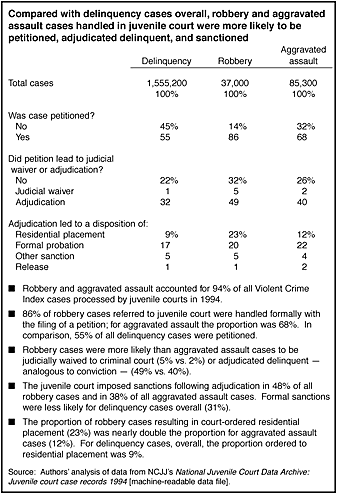|
Juvenile courts handled a growing number of violent cases and were tougher on them than on other cases
Juvenile court caseloads are rising and growing more violent In 1994 U.S. courts with juvenile jurisdiction handled an estimated 1,555,200 cases in which the juvenile was charged with a delinquency offense -- an offense for which an adult could be prosecuted in criminal court. This was a 41% increase over the number of cases handled in 1985. In addition to handling more cases, the nature of the caseload has changed. Between 1985 and 1994 juvenile courts experienced disproportionate increases in cases involving violent offenses and weapons. Cases involving crimes against persons were up 93%, Violent Crime Index offenses (a subset of person offenses) were up 98%, and weapons law violations were up 156%. Robbery and aggravated assault cases were more common than cases of other serious violence Although homicide and forcible rape cases attract a substantial amount of public attention, they account for a small fraction of person offense cases referred to juvenile court in 1994 (2%). Cases involving aggravated assault and robbery were more common (26% and 11% of person offense cases, respectively). Most cases referred for person offenses involved the relatively less serious offense of simple assault (53%). To get a better sense of how juvenile courts handle violent cases, the case processing of robbery and aggravated assault cases was analyzed. Homicide and forcible rape cases were excluded from this analysis because there were too few cases to obtain reliable results. Most robbery and aggravated assault cases were referred to court by law enforcement Overall, 86% of delinquency cases were referred to juvenile court by law enforcement agencies in 1994. Other sources of referral include schools, parents, probation officers, and victims. The proportion of cases referred by law enforcement was higher for aggravated assault (91%) and robbery (96%) cases.
Offenders in robbery and aggravated assault cases differ The majority of offenders for both aggravated assault and robbery cases were male, but aggravated assault cases had a larger share of females. Aggravated assault cases also had a larger proportion of white offenders than robbery cases. Compared with robbery cases, aggravated assault cases were made up of a somewhat greater proportion of youth age 13 or younger. This was offset by a smaller proportion of juveniles ages 14 and 15.
Detention was more likely in robbery and aggravated assault cases than in most other types of delinquency cases A youth may be securely detained at various points during the processing of a case through the juvenile justice system. When a case is referred to juvenile court, intake staff may decide to hold the youth in a detention facility while the case is being processed. Although detention practices vary from jurisdiction to jurisdiction, in general, the youth will be detained if there is reason to believe the youth -
The youth may also be detained for diagnostic evaluation. In all States, legislation requires that a detention hearing be held within a few days (generally within 24 hours). At that time a judge reviews the detention decision and either orders the youth released or continues the detention. In 21% of delinquency cases disposed in 1994, the juvenile was held in secure detention at some point between referral to court intake and case disposition. The use of detention varied by offense but was substantially more likely among aggravated assault and robbery cases than other types of delinquency cases:

|
| Previous | Contents | Next |
|
Juvenile Offenders and Victims: 1997 Update on Violence |